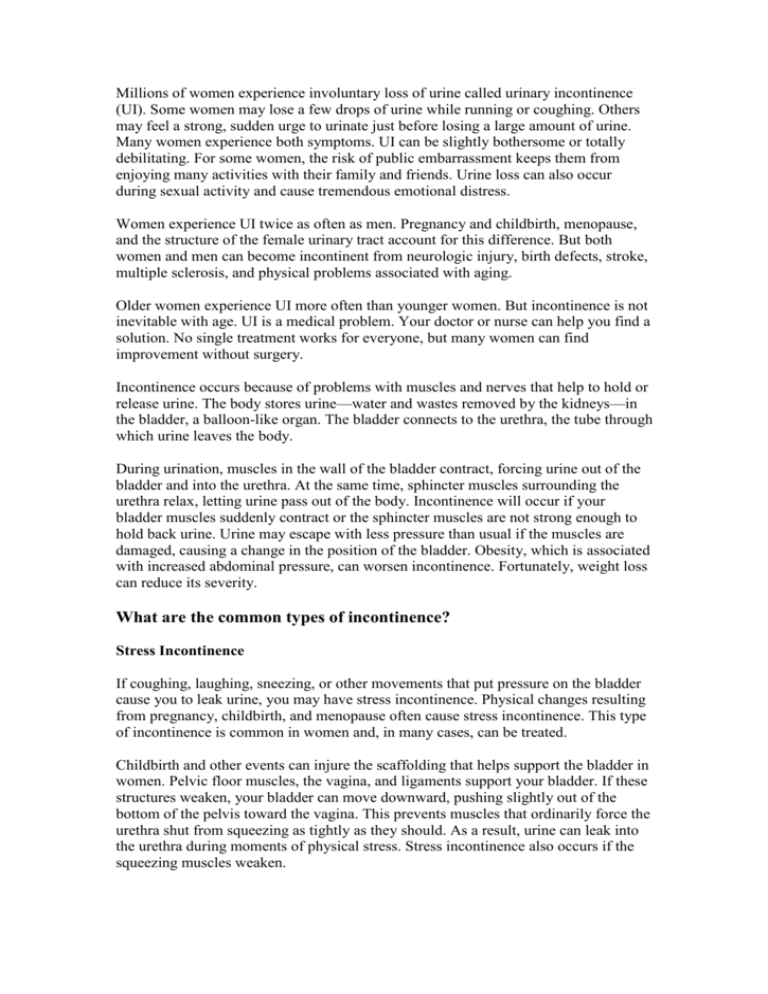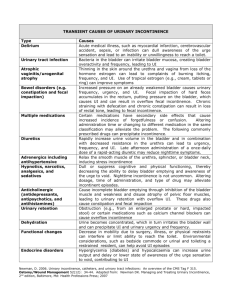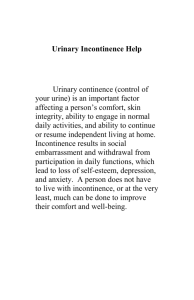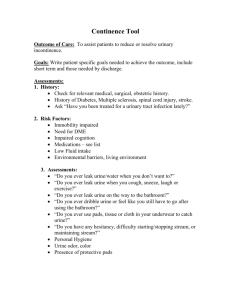Millions of women experience involuntary loss of urine called urinary
advertisement

Millions of women experience involuntary loss of urine called urinary incontinence (UI). Some women may lose a few drops of urine while running or coughing. Others may feel a strong, sudden urge to urinate just before losing a large amount of urine. Many women experience both symptoms. UI can be slightly bothersome or totally debilitating. For some women, the risk of public embarrassment keeps them from enjoying many activities with their family and friends. Urine loss can also occur during sexual activity and cause tremendous emotional distress. Women experience UI twice as often as men. Pregnancy and childbirth, menopause, and the structure of the female urinary tract account for this difference. But both women and men can become incontinent from neurologic injury, birth defects, stroke, multiple sclerosis, and physical problems associated with aging. Older women experience UI more often than younger women. But incontinence is not inevitable with age. UI is a medical problem. Your doctor or nurse can help you find a solution. No single treatment works for everyone, but many women can find improvement without surgery. Incontinence occurs because of problems with muscles and nerves that help to hold or release urine. The body stores urine—water and wastes removed by the kidneys—in the bladder, a balloon-like organ. The bladder connects to the urethra, the tube through which urine leaves the body. During urination, muscles in the wall of the bladder contract, forcing urine out of the bladder and into the urethra. At the same time, sphincter muscles surrounding the urethra relax, letting urine pass out of the body. Incontinence will occur if your bladder muscles suddenly contract or the sphincter muscles are not strong enough to hold back urine. Urine may escape with less pressure than usual if the muscles are damaged, causing a change in the position of the bladder. Obesity, which is associated with increased abdominal pressure, can worsen incontinence. Fortunately, weight loss can reduce its severity. What are the common types of incontinence? Stress Incontinence If coughing, laughing, sneezing, or other movements that put pressure on the bladder cause you to leak urine, you may have stress incontinence. Physical changes resulting from pregnancy, childbirth, and menopause often cause stress incontinence. This type of incontinence is common in women and, in many cases, can be treated. Childbirth and other events can injure the scaffolding that helps support the bladder in women. Pelvic floor muscles, the vagina, and ligaments support your bladder. If these structures weaken, your bladder can move downward, pushing slightly out of the bottom of the pelvis toward the vagina. This prevents muscles that ordinarily force the urethra shut from squeezing as tightly as they should. As a result, urine can leak into the urethra during moments of physical stress. Stress incontinence also occurs if the squeezing muscles weaken. Stress incontinence can worsen during the week before your menstrual period. At that time, lowered estrogen and higher progesterone levels might lead to lower muscular pressure around the urethra, increasing chances of leakage. The incidence of stress incontinence increases following menopause. Urge Incontinence If you lose urine for no apparent reason after suddenly feeling the need or urge to urinate, you may have urge incontinence. A common cause of urge incontinence is inappropriate bladder contractions. Abnormal nerve signals might be the cause of these bladder spasms. Urge incontinence can mean that your bladder empties during sleep, after drinking a small amount of water, or when you touch water or hear it running (as when washing dishes or hearing someone else taking a shower). Certain fluids and medications such as diuretics or emotional states such as anxiety can worsen this condition. Some medical conditions, such as hyperthyroidism and uncontrolled diabetes, can also lead to or worsen urge incontinence. Involuntary actions of bladder muscles can also occur because of damage to the nerves of the bladder, to the nervous system (spinal cord and brain), or to the muscles themselves. Multiple sclerosis, Parkinson’s disease, Alzheimer’s disease, stroke, and injury—including injury that occurs during surgery—all can harm bladder nerves or muscles. Overactive Bladder Overactive bladder occurs when abnormal nerves send signals to the bladder at the wrong time, causing its muscles to squeeze without warning. Voiding up to seven times a day is normal for many women, but women with overactive bladder may find that they must urinate even more frequently. Specifically, the symptoms of overactive bladder include urinary frequency—bothersome urination eight or more times a day or two or more times at night urinary urgency—the sudden, strong need to urinate immediately urge incontinence—leakage or gushing of urine that follows a sudden, strong urge nocturia—awaking at night to urinate Functional Incontinence People with medical problems that interfere with thinking, moving, or communicating may have trouble reaching a toilet. A person with Alzheimer’s disease, for example, may not think well enough to plan a timely trip to a restroom. A person in a wheelchair may have a hard time getting to a toilet in time. Functional incontinence is the result of these physical and medical conditions. Conditions such as arthritis often develop with age and account for some of the incontinence of elderly women in nursing homes. Overflow Incontinence Overflow incontinence happens when the bladder doesn’t empty properly, causing it to spill over. Your doctor can check for this problem. Weak bladder muscles or a blocked urethra can cause this type of incontinence. Nerve damage from diabetes or other diseases can lead to weak bladder muscles; tumors and urinary stones can block the urethra. Overflow incontinence is rare in women. Other Types of Incontinence Stress and urge incontinence often occur together in women. Combinations of incontinence—and this combination in particular—are sometimes referred to as mixed incontinence. Most women don’t have pure stress or urge incontinence, and many studies show that mixed incontinence is the most common type of urine loss in women. Transient incontinence is a temporary version of incontinence. Medications, urinary tract infections, mental impairment, and restricted mobility can all trigger transient incontinence. Severe constipation can cause transient incontinence when the impacted stool pushes against the urinary tract and obstructs outflow. A cold can trigger incontinence, which resolves once the coughing spells cease. The Types of Urinary Incontinence Stress Leakage of small amounts of urine during physical movement (coughing, sneezing, exercising). Urge Leakage of large amounts of urine at unexpected times, including during sleep. Overactive Bladder Urinary frequency and urgency, with or without urge incontinence. Functional Untimely urination because of physical disability, external obstacles, or problems in thinking or communicating that prevent a person from reaching a toilet. Overflow Unexpected leakage of small amounts of urine because of a full bladder. Mixed Usually the occurrence of stress and urge incontinence together. Transient Leakage that occurs temporarily because of a situation that will pass (infection, taking a new medication, colds with coughing). How is incontinence evaluated? The first step toward relief is to see a doctor who has experience treating incontinence to learn what type you have. Gynaecologists specialise in the female reproductive tract and childbirth. A urogynecologist focuses on urinary and associated pelvic problems in women. Family practitioners and internists see patients for all kinds of health conditions. Any of these doctors may be able to help you. In addition, some nurses and also physiotherapists often provide rehabilitation services and teach behavioral therapies such as fluid management and pelvic floor strengthening. To diagnose the problem, your doctor will first ask about symptoms and medical history. Your pattern of voiding and urine leakage may suggest the type of incontinence you have. Thus, many specialists begin with having you fill out a bladder diary over several days. These diaries can reveal obvious factors that can help define the problem—including straining and discomfort, fluid intake, use of drugs, recent surgery, and illness. Often you can begin treatment at the first medical visit. Your doctor may instruct you to keep a diary for a day or more—sometimes up to a week—to record when you void. This diary should note the times you urinate and the amounts of urine you produce. To measure your urine, you can use a special pan that fits over the toilet rim. You can also use the bladder diary to record your fluid intake, episodes of urine leakage, and estimated amounts of leakage. If your diary and medical history do not define the problem, they will at least suggest which tests you need. Your doctor will physically examine you for signs of medical conditions causing incontinence, including treatable blockages from bowel or pelvic growths. In addition, weakness of the pelvic floor leading to incontinence may cause a condition called prolapse, where the vagina or bladder begins to protrude out of your body. This condition is also important to diagnose at the time of an evaluation. Your doctor may measure your bladder capacity. The doctor may also measure the residual urine for evidence of poorly functioning bladder muscles. To do this, you will urinate into a measuring pan, after which the nurse or doctor will measure any urine remaining in the bladder. Your doctor may also recommend other tests: Bladder stress test—You cough vigorously as the doctor watches for loss of urine from the urinary opening. Urinalysis and urine culture—Laboratory technicians test your urine for evidence of infection, urinary stones, or other contributing causes. Ultrasound—This test uses sound waves to create an image of the kidneys, ureters, bladder, and urethra. Cystoscopy—The doctor inserts a thin tube with a tiny camera in the urethra to see inside the urethra and bladder. Urodynamics—Various techniques measure pressure in the bladder and the flow of urine. How is incontinence treated? Behavioral Remedies: Bladder Retraining and Pelvic Floor Exercises Bladder retraining for urgency and overactive bladder By looking at your bladder diary, the doctor may see a pattern and suggest making it a point to use the bathroom at regular timed intervals, a habit called timed voiding. As you gain control, you can extend the time between scheduled trips to the bathroom. The object of this bladder retraining is to teach the bladder to hold larger volumes of fluid without trying to empty itself without your permission. It is slightly like ‘toilet training’ that toddlers undergo naturally. Full details are on the bladder retraining info sheet in the treatment link. Bladder retraining along with appropriate fluid intake forms the basis of management for this condition but medicines may sometimes be required if you are finding it difficult to increase your times between going to the toilet. How do you do pelvic floor exercises? These are best taught by a specialist nurse or physiotherapist. The first step is to find the right muscles. One way to find them is to imagine that you are sitting on a marble and want to pick up the marble with your vagina. Imagine sucking or drawing the marble into your vagina. Try not to squeeze other muscles at the same time. Be careful not to tighten your stomach, legs, or buttocks. Squeezing the wrong muscles can put more pressure on your bladder control muscles. Just squeeze the pelvic muscles. Don’t hold your breath. Do not practice while urinating. Repeat, but don’t overdo it. At first, find a quiet spot to practice—your bathroom or bedroom—so you can concentrate. Pull in the pelvic muscles and hold for a count of three. Then relax for a count of three. Work up to three sets of 10 repeats. Start doing your pelvic muscle exercises lying down. This is the easiest position to do them in because the muscles do not need to work against gravity. When your muscles get stronger, do your exercises sitting or standing. Working against gravity is like adding more weight. Be patient. Don’t give up. It takes just 5 minutes a day. You may not feel your bladder control improve for 3 to 6 weeks. Still, most people do notice an improvement after a few weeks. Some people with nerve damage cannot tell whether they are doing pelvic floor exercises correctly. If you are not sure, ask your doctor or physio to examine you while you try to do them. If it turns out that you are not squeezing the right muscles, you may still be able to learn the proper technique by doing special training with biofeedback, electrical stimulation, or both. Medicines for Overactive Bladder and Stress Incontinence If you have an overactive bladder, your doctor may prescribe a medicine to block the nerve signals that cause frequent urination and urgency. Several medicines from a class of drugs called anticholinergics can help relax bladder muscles and prevent bladder spasms. Their most common side effect is dry mouth, although larger doses may cause blurred vision, constipation, a faster heartbeat, and flushing. Other side effects include drowsiness, confusion, or memory loss. If you have glaucoma, ask your ophthalmologist if these drugs are safe for you. Some medicines can affect the nerves and muscles of the urinary tract in different ways. Pills to treat swelling (oedema) or high blood pressure may increase your urine output and contribute to bladder control problems. Talk with your doctor; you may find that taking an alternative to a medicine you already take may solve the problem without adding another prescription. For those who do not respond to behavioural therapy, physiotherapy or medication good results can be obtained with the injection of Botox into the walls of the bladder. This often needs to be repeated but can give good relief whilst active. Duloxetine (Yentreve) is a medication which helps increase the tone of the sphincter muscle which surrounds the urethra. It can reduce the severity of stress incontinence but must be used in conjunction with pelvic floor exercises. Biofeedback Biofeedback uses measuring devices to help you become aware of your body’s functioning. By using electronic devices or diaries to track when your bladder and urethral muscles contract, you can gain control over these muscles. Biofeedback can supplement pelvic muscle exercises and electrical stimulation to relieve stress and urge incontinence. Neuromodulation For urge incontinence not responding to behavioural treatments, drugs or Botox injections, stimulation of nerves to the bladder leaving the spine can be effective in some patients. Neuromodulation is the name of this therapy. The doctor applies an external stimulator to determine if neuromodulation works in you. If you have a 50 percent reduction in symptoms, a surgeon can implant the device. Although neuromodulation can be effective, it is not for everyone. The therapy is expensive, involving surgery with possible surgical revisions and replacement. Vaginal Devices for Stress Incontinence One of the reasons for stress incontinence may be weak pelvic muscles, the muscles that hold the bladder in place and hold urine inside. A pessary is a stiff ring that a doctor or nurse inserts into the vagina, where it presses against the wall of the vagina and the nearby urethra. The pressure helps reposition the urethra, leading to less stress leakage. If you use a pessary, you should watch for possible vaginal and urinary tract infections and see your doctor regularly. Injections for Stress Incontinence A variety of bulking agents, such as collagen and carbon spheres, are available for injection near the urinary sphincter. The doctor injects the bulking agent into tissues around the bladder neck and urethra to make the tissues thicker and close the bladder opening to reduce stress incontinence. After using local anaesthesia or sedation, a doctor can inject the material in about half an hour. Over time, the body may slowly eliminate certain bulking agents, so you will need repeat injections. Before you receive an injection, a doctor may perform a skin test to determine whether you could have an allergic reaction to the material. Scientists are testing newer agents, including your own muscle cells, to see if they are effective in treating stress incontinence. Your doctor will discuss which bulking agent may be best for you. Surgery for Stress Incontinence In some women, the bladder can move out of its normal position, especially following childbirth. Surgeons have developed different techniques for supporting the bladder back to its normal position. The three main types of surgery are retropubic suspension and two types of sling procedures. Midurethral slings are now the most commonly performed operations and have good results with quick recovery Retropubic suspension uses surgical threads called sutures to support the bladder neck. The most common retropubic suspension procedure is called the Burch procedure. In this operation, the surgeon makes an incision in the abdomen a few inches below the navel and then secures the threads to strong ligaments within the pelvis to support the urethral sphincter. Sling procedures are performed through a vaginal incision. The traditional sling procedure uses a strip of your own tissue called fascia to cradle the bladder neck. Some slings may consist of natural tissue or man-made material. The surgeon attaches both ends of the sling to the pubic bone or ties them in front of the abdomen just above the pubic bone. Midurethral slings are newer procedures that you can have on an outpatient basis. These procedures use synthetic mesh materials that the surgeon places midway along the urethra. The two general types of midurethral slings are retropubic slings, such as the transvaginal tapes (TVT), and transobturator slings (TOT). The surgeon makes small incisions behind the pubic bone or just by the sides of the vaginal opening as well as a small incision in the vagina. The surgeon uses specially designed needles to position a synthetic tape under the urethra. The surgeon pulls the ends of the tape through the incisions and adjusts them to provide the right amount of support to the urethra. Other Helpful Hints Many women manage urinary incontinence with menstrual pads that catch slight leakage during activities such as exercising. Also, many people find they can reduce incontinence by restricting caffeine containing liquids, such as coke, coffee and tea, and also alcohol. Finally, many women are afraid to mention their problem. They may have urinary incontinence that can improve with treatment but remain silent sufferers and resort to wearing absorbent undergarments. This practice is unfortunate, because this can lead to diminished self-esteem, as well as skin irritation and sores. If you are relying on pads to manage your incontinence, you should discuss with your doctor the possible options as described.





